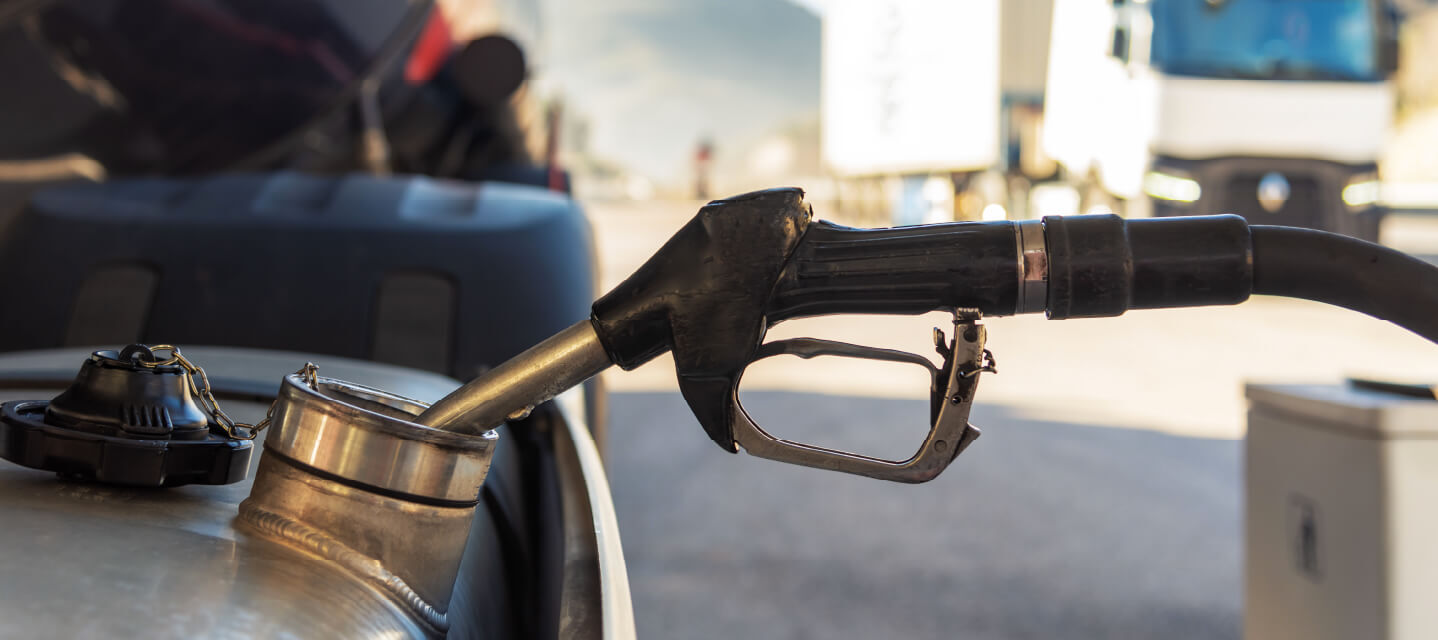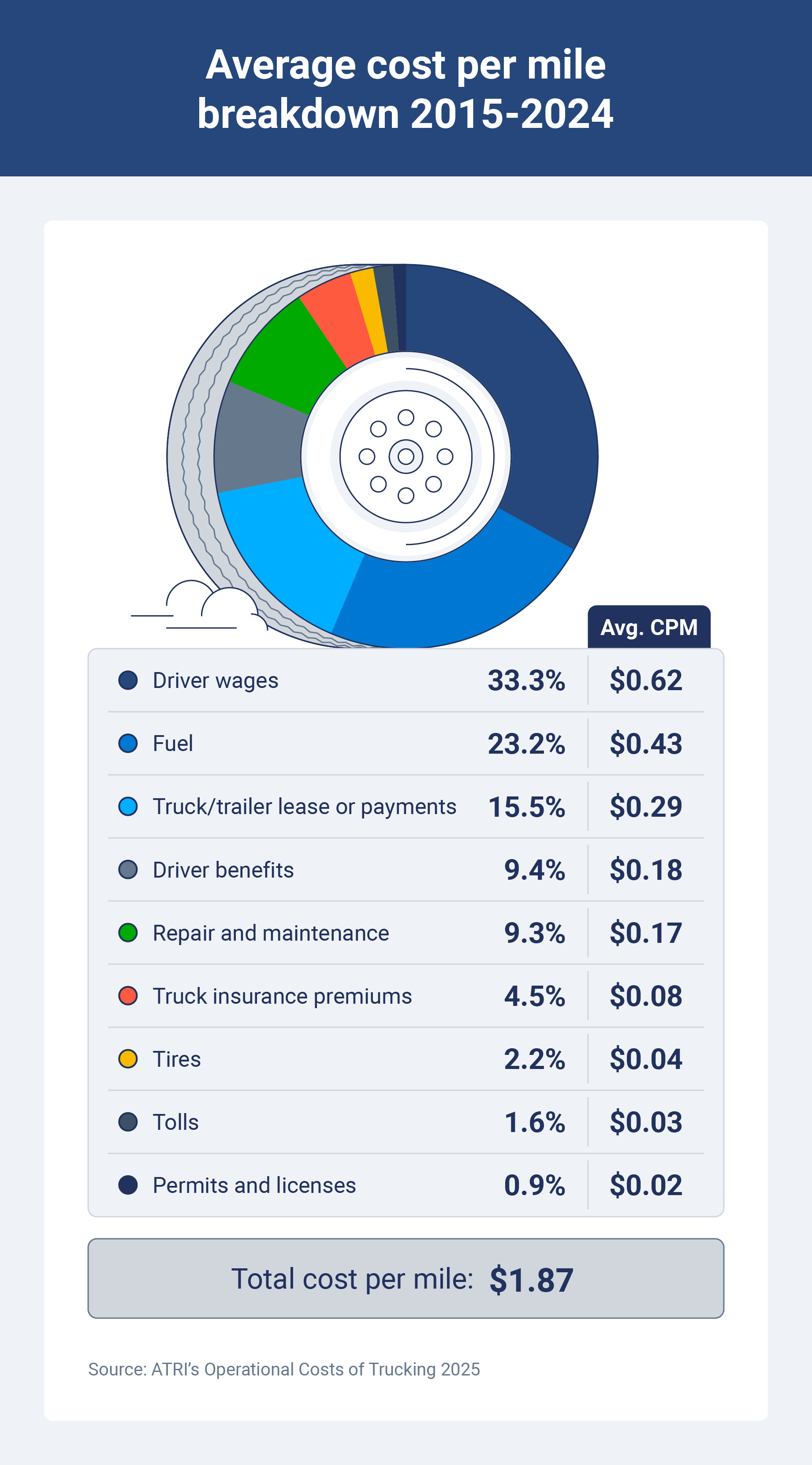Trucking cost per mile calculator: Drive smarter, spend less
The average cost for trucking has increased to $2.27 per mile in 2024. Determine your trucking cost per mile with our calculator to uncover inefficiencies and identify opportunities for increased savings so you can boost your bottom line.
By Geotab Team
Sep 2, 2025

Key Insights
- Understanding fixed, variable and driver-related expenses per mile is essential for accurate budgeting and strategic decision-making.
- Proactive routine maintenance, route optimization and driver behavior monitoring can help you lower your average cost per mile.
Trucking costs continue to increase, according to some of the latest trucking industry statistics, with the average cost reaching a new high of $2.27 per mile. Using a trucking cost per mile calculator can give you more visibility and influence over your business, which can lead to significant savings and improvements in efficiency.
Trucking cost per mile calculator
For the best results, we recommend using monthly totals for your entire fleet when calculating cost per mile. But as long as you use the same time frame and number of trucks across all data inputs, you’ll get an accurate estimate of how much you spend on your trucking business for every mile you cover.
Cost per mile formula
Calculating cost per mile is simple if you know your total monthly costs and total miles driven.
| Total costs / Miles driven = Cost per mile |
But if you don’t have those totals on hand or you want a more in-depth breakdown of different monthly costs per mile, use the calculator below. Note that you will need to indicate a minimum of one truck, and leaving any field blank will assign it a value of zero.
How to calculate cost per mile for trucking
To calculate monthly cost per mile, you’ll need:
- The size of your fleet
- The number of miles driven by your truck or fleet
- How much you earned from your trucking business
- Fixed monthly expenses, including payments, interest and insurance
- Variable monthly expenses, such as fuel costs, tolls and repairs
- How much you spent on drivers’ salaries, insurance and taxes

1. Add up fixed costs
Fixed costs are expenses that generally remain the same each month, regardless of how many miles your truck travels. These are essential costs that keep your business running, including:
- Truck and trailer payments: Your regular payments or leases for the trucks and trailers themselves
- Loan interest: Any interest accrued on loans related to your trucking business
- Insurance: Includes all types of coverage, from liability and cargo to commercial truck insurance
- Permits and licenses: Regular fees for operating permits and licenses, like CDLs, which are usually billed annually
- Taxes and fees: Other recurring taxes or administrative fees for bookkeeping, telematics and more
- Miscellaneous: Any other consistent monthly expenses that don't fit into the above categories, including cell phone or internet payments and software subscriptions
Example:
| Truck payment or lease | $1,500 |
| Trailer payment or lease | $500 |
| Loan interest | $200 |
| Insurance | $800 |
| Permits and licenses | $100 |
| Taxes and fees | $50 |
| Miscellaneous | $75 |
| Total fixed costs | $3,225 |
2. Add up variable costs
Variable costs fluctuate based on how much you operate your truck or fleet. The more miles you cover, the higher these costs tend to be. They include things like:
- Fuel: A significant expense that varies due to fluctuating fuel costs over time and across different locations
- Food and lodging: Expenses incurred by drivers for meals and overnight stays on the road
- Tolls: Costs for using toll roads, bridges and tunnels
- Freight costs: Any direct costs associated with the freight you are hauling, such as specialized equipment or customs fees
- Maintenance and repairs: The cost of keeping your truck in good working order, including routine maintenance and unexpected repairs
- Miscellaneous expenses: Other fluctuating costs not covered above, such as parking or scale fees
Example:
| Fuel | $4,000 |
| Food and lodging | $500 |
| Tolls | $150 |
| Freight costs | $300 |
| Maintenance and repairs | $700 |
| Miscellaneous expenses | $100 |
| Total variable costs | $5,750 |
Reducing fleet fuel costs naturally cuts down on your cost per mile and grants you more resources to allocate wherever you need them most.
3. Identify driver costs
Driver costs include all expenses related to employing your drivers, encompassing their direct wages and other associated benefits and taxes. These are crucial to calculating your complete operational expenses.
- Wages and payroll fees: The gross pay for your drivers plus any processing fees
- Insurance and benefits: Costs for health insurance, workers' compensation and other benefits provided to drivers
- Taxes: Employer-paid taxes associated with driver salaries, such as FICA
Example:
| Monthly wages and payroll fees | $6,000 |
| Insurance and benefits | $1,200 |
| Taxes | $400 |
| Total driver costs | $7,600 |
4. Determine total miles driven
To determine total miles driven, simply record the total number of miles your truck or fleet has covered within the chosen time frame (monthly is recommended). This is usually tracked via an odometer or fleet management system. Knowing your trucking miles per gallon (MPG) can also help you estimate future fuel costs more accurately.
You can also factor a vehicle’s MPG into your calculations if you don’t know exactly how far your truck has traveled.
Example:
| Average miles per gallon | 8.2 |
| Fuel capacity | 200 gallons |
| Amount of gas used | 6.01 tanks = 1,219 gallons |
| Estimated miles driven | 10,000 |
An accurate estimate of total miles driven will give you the best idea of how much you’re spending per mile. Tracking distance by routinely monitoring odometers and using telematics can help you identify inefficiencies so you can improve the cost-effectiveness of your operations.
5. Calculate cost per mile
Once you’ve identified how many miles your truck has driven and added up your fixed costs, variable costs and driver costs, you can easily calculate your cost per mile using the formula:
| (Fixed costs + Variable costs + Driver costs) / Miles driven = Cost per mile |
Using the examples we provided above, that would look like:
| ($3,225 + $5,750 + $7,600) / 10,000 = $1.66 per mile |
In this scenario, that means it costs you about $1.66 for every mile your truck operates.
Why your cost per mile matters
Your cost per mile can reveal actionable insights into your trucking business’s expenses and profitability. By calculating how much money you spend per mile and breaking down key factors, you can investigate:
- Fuel inefficiencies: Identifying patterns of inefficient fuel use can help you make changes like route optimization or additional driver training to improve fuel economy.
- Detrimental driver behaviors: Aggressive driving can impact fuel consumption and maintenance requirements. Encourage smooth acceleration and other safe habits to minimize risk and improve efficiency.
- Fleet management practices: Knowing how much you spend per mile can inform management decisions like when to replace a truck and what types of loads to prioritize.
- Opportunities for cost savings: When you know your costs down to the mile, you can pinpoint areas to cut expenses without compromising service quality.
Tracking and monitoring your operational costs is essential for sustainable business growth, allowing you to plan strategically. A clear understanding of your cost per mile allows you to create more accurate and realistic budgets for future operations, ensuring you allocate resources effectively.
Ways to lower your average cost per mile
Knowing how much you’re spending for every mile you travel can shed light on inefficiencies and other areas for improvement, and what you do with that information can affect your bottom line.
Using telematics to lower fleet costs not only saves your business money but also provides concrete data and valuable insights to improve performance and profitability.
Here are six ways you can reduce your cost per mile:
Prioritize routine maintenance
Sticking to a preventative maintenance schedule allows you to catch minor issues before they escalate into major, costly breakdowns. By prioritizing proactive maintenance, you can avoid expensive repairs and unexpected downtime.
Optimize trucking routes
Plotting out the most efficient routes and adapting to real-time traffic data can have a significant impact on your expenses by:
- Minimizing miles driven
- Avoiding tolls
- Bypassing congested areas
Carefully planning your routes can directly lower fuel consumption and reduce vehicle wear and tear.
Optimize your fleet with Geotab telematics
Strategically accept jobs
Not all loads are created equal. Focus on securing high-paying loads that maximize your revenue per mile. When able, strive to minimize deadheading or driving a bobtail truck to ensure every possible mile generates income.
Negotiate fuel discounts
You can’t avoid purchasing fuel for your fleet, but you can cut down on the expense. Leverage your fleet's purchasing power by negotiating discounts with fuel suppliers or using fleet fuel cards to get wholesale pricing, saving you a lot of money over time.
Monitor and correct driver behavior
Excessive idling, harsh braking and rapid acceleration may use more fuel and increase maintenance costs. Implementing telematics solutions allows you to monitor these behaviors and provide targeted coaching, helping drivers adopt safer driving practices.
Encourage safe driving with Geotab
Track and analyze fleet costs
Every dollar you spend on fuel, lodging, tolls and maintenance contributes to your overall operational expenses. Diligently tracking all of this financial data allows you to identify spending patterns, uncover hidden costs and make informed decisions to improve efficiency and profitability.
Optimize trucking costs and fleet performance with Geotab
Estimating your expense breakdown using our trucking cost per mile calculator and implementing the strategies discussed above means you're well on your way to a more profitable and efficient operation.
The more you improve the logistics of your fleet, the more cost-effective your operations will be. Leverage all the tools at your disposal, from AI in fleet management to telematics devices, to gain deeper insight into your spending and inform your strategic decisions.
Learn how Geotab can help you gain a complete picture of your fleet's performance, unlock further savings and maximize the efficiency of your operations with our comprehensive fleet management solutions.
Subscribe to get industry tips and insights
The Geotab Team write about company news.
Table of Contents
Subscribe to get industry tips and insights
Related posts

The $4B Crisis: Video Intelligence as the Answer to Fleet Distraction
December 2, 2025
3 minute read

The True Cost of Cargo Theft: When Customer Trust is on the Line
November 24, 2025
2 minute read

Telematics device cost: Key factors that determine pricing
November 19, 2025
5 minute read

Law enforcement technology: Four trends to know for 2026
November 7, 2025
6 minute read

Four seasons of fleet intelligence with Geotab's Public Works solution
November 7, 2025
2 minute read

Infographic: What are the ripple effects of school bus driver turnover?
November 6, 2025
1 minute read